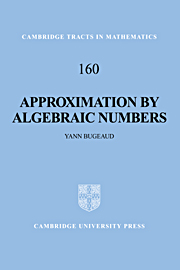Book contents
- Frontmatter
- Contents
- Preface
- Frequently used notation
- 1 Approximation by rational numbers
- 2 Approximation to algebraic numbers
- 3 The classifications of Mahler and Koksma
- 4 Mahler's Conjecture on S-numbers
- 5 Hausdorff dimension of exceptional sets
- 6 Deeper results on the measure of exceptional sets
- 7 On T-numbers and U-numbers
- 8 Other classifications of real and complex numbers
- 9 Approximation in other fields
- 10 Conjectures and open questions
- Appendix A Lemmas on polynomials
- Appendix B Geometry of numbers
- References
- Index
8 - Other classifications of real and complex numbers
Published online by Cambridge University Press: 12 August 2009
- Frontmatter
- Contents
- Preface
- Frequently used notation
- 1 Approximation by rational numbers
- 2 Approximation to algebraic numbers
- 3 The classifications of Mahler and Koksma
- 4 Mahler's Conjecture on S-numbers
- 5 Hausdorff dimension of exceptional sets
- 6 Deeper results on the measure of exceptional sets
- 7 On T-numbers and U-numbers
- 8 Other classifications of real and complex numbers
- 9 Approximation in other fields
- 10 Conjectures and open questions
- Appendix A Lemmas on polynomials
- Appendix B Geometry of numbers
- References
- Index
Summary
In 1932, Mahler [376] introduced the first relevant classification of complex numbers into several classes. To this end, for given positive integers n and H and for any complex number ξ, he considered the minimum of the real numbers |P(ξ)|, where P(X) runs through the (finite) set of integer polynomials of degree at most n and height at most H, which do not vanish at ξ. Then, he let first H tend to infinity, and then n. This order is arbitrary, and we may as well do the converse, or let tend to infinity some given function of the height and the degree. The former suggestion has been proposed by Sprindžuk [532] in 1962, and the latter one by Mahler [393] in 1971. Both yield new classifications of complex numbers, to which Sections 8.1 and 8.2 are devoted, respectively. In Section 8.3, we present further results on the approximation by algebraic numbers, which, to some extend, refine Wirsing's Theorem 3.4.
Unlike in the previous chapters, we approximate complex numbers, and not only real numbers. The main reason for doing this is that the results obtained here are not sharp enough to ensure that, when we start with a real number, the approximants we construct are also real numbers.
- Type
- Chapter
- Information
- Approximation by Algebraic Numbers , pp. 166 - 190Publisher: Cambridge University PressPrint publication year: 2004

